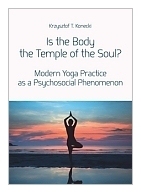|
||
• wydawnictwa polskie
• Zamów informacje o nowościach z wybranego tematu • kontakt
• Cookies na stronie |
IS THE BODY THE TEMPLE OF THE SOUL? MODERN YOGA PRACTICE AS A PSYCHOLOGICAL PHENOMENONKONECKI K.T.wydawnictwo: WYD UN ŁÓDŹ , rok wydania 2015, wydanie Icena netto: Is the Body the Temple of the Soul?Modern Yoga Practice as a Psychological PhenomenonHatha-yoga in Western culture is often perceived as the practice of physical exercises (practice of the asana position), usually done to improve one’s health and emotional state. Even if that is the case, it is still based on the rule of “the silencing of the modifications of the mind.” It is about a containment of mind dispersion in terms of non-important, minute, everyday issues, which are not important for the basis of our existence, balance and inner harmony, the unity of body and mind. Even if we train only for our health and for improvement of our physical fitness, then the end result, in the case of many physical and sports activities, is stopping mind movement. The full concentration on one action, on one point in space, might not have any metaphysical meaning for us, but it still remains full concentration. This can be achieved by patiently practicing hatha-yoga. Foreword (Michał Szczepanik)
Chapter 1. Philosophy and hatha-yoga practice. Para-religious aspects of
hatha-yoga
Chapter 2. The social world of yoga practice
Chapter 3. Commonsense definitions of yoga and its meaning for practitioners
Chapter 4. The process of becoming a hatha-yoga practitioner Chapter 5. Visual transmission of knowledge and the meaning of corporality and
gestures in the social world of yoga practice Chapter 6. Emotions and yoga practicing. Working on emotions and achieving “emotional
culture” without emotions Chapter 7. Teacher and guru in hatha-yoga practice
Conclusions
226 pages, Paperback Księgarnia nie działa. Nie odpowiadamy na pytania i nie realizujemy zamówien. Do odwolania !. |


